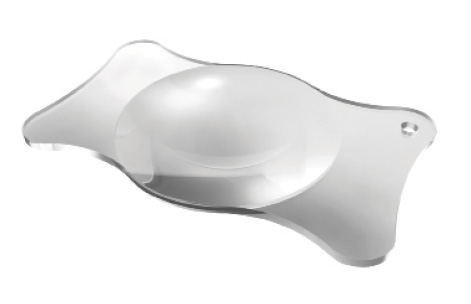I have been implanting the aberration-neutral aspheric CT Asphina 409M/MP (Carl Zeiss Meditec) and its microincision cataract surgery (MICS) relatives (see
The design of the CT Asphina 409M/MP and the other lenses in this platform features four-point plate haptics and one-piece construction from a hydrophilic acrylic material with hydrophobic surface properties. The lens fits consistently through a microincision of well under 2 mm. The
BUILT ON THE SAME PLATFORM
Aspheric
CT Asphina 409M/MP (Aberration neutral)
CT Asphina 509M/MP (Aberration correction)
Toric
AT Torbi 709M/MP
Bifocal/Bifocal Toric
AT LISA 809M/MP
AT LISA toric 909M/MP
Trifocal/Trifocal Toric
AT LISA tri 839M/MP
AT LISA tri toric 939M/MP
The CT Asphina 409M/MP is quite popular in my clinic, and this is also the case in other parts of Germany. It is, however, less well-known in other parts of Europe. Let me explain why this is with a simple anecdote: In my clinic, colleagues can watch my cataract surgery directly through the microscope or on the monitor, giving them a firsthand look at how gentle, comfortable, and safe surgery with the Asphina 409M/MP can be. They can ask me what is the best way to swap their own IOL for the 409M/MP. Because of that experience, most of my colleagues have switched their previous favorite IOL for the CT Asphina 409M/MP. These same colleages have also talked positively about the 409M/MP to other surgeons in Germany. So, over the years, more surgeons have started to use this IOL, despite earlier great resistance toward four-plate haptic designs in the German market. As to why the popularity of this lens has not penetrated to other parts of Europe, maybe this word-of-mouth recommendation has not broken through the language barrier.
COMFORT IN SURGERY
My belief is that the best surgical performance and the best safety one can achieve in cataract surgery come when the surgeon feels comfortable with the lens being implanted. In my hands, I am most comfortable with the CT Asphina 409M/MP and the other lenses in this MICS platform. This is, in large part, because I know I can comfortably implant a multifocal or multifocal toric IOL with no change in surgical or implantation procedure from a standard monofocal lens.

The key reason that I like the CT Asphina 409MP is because I can implant it comfortably through a very small incision, 1.6 to 1.8 mm, using the BlueMixs 180 inserter. To do this, I use a docking technique, docking the tip of the injector at the mouth of the incision and injecting the lens through the incision into the eye. In other words, I do not insert the injector completely into the incision; for that to be done, the incision must be widened to 1.8 or 2 mm.
With this familiar routine, I can implant the CT Asphina 409M/MP even in difficult cases. In a normal eye, any lens can be implanted with relative ease: three-piece IOLs and lenses of different materials and designs, for example. But, especially when faced with a complicated case—whether a small pupil, a flat anterior chamber, high posterior pressure, or some other challenge—the surgeon benefits from a lens that is safe and comfortable to implant, which, for me, is the CT Asphina 409M/MP.
EASY IMPLANTATION
Implantation of the CT Asphina is straightforward. As mentioned, it is implanted easily through an incision of 1.8 mm or less with the BlueMixs 180 injector. After I inflate the capsular bag with OVD to facilitate unfolding and firming up the eye, I implant the first haptic into the capsular bag. Then it is easy to push the second haptic into the bag.
THe Lens: CT Asphina 409M/MP
CARL ZEISS MEDITEC
• Monofocal, aspheric, aberration-neutral optic
• Hydrophilic acrylic material with hydrophobic surface properties
• Overall length 11 mm; optic diameter 6 mm
• One-piece plate-haptic design with four-point fixation for exceptional rotational stability
• Available powers 0.00 to 32.00 D, with 10.00 to 30.00 D in 0.50 D steps
• Optional injector cartridge (BlueMixs 180; Carl Zeiss Meditec) with the CT Asphina MP model allows implantation through 1.8-mm incision
For more information: https://www.zeiss.com/meditec/int/products/ophthalmology-optometry/cataract/iol-implantation/mics-platform.html

Courtesy of Carl Zeiss Meditec
There is little or no learning curve, and the implantation technique is highly reproducible and safe for any eye. In my experience, there is no eye for which the CT Asphina 409M/MP is not suitable.
I specifically recall one difficult case in which the 409M/MP had big advantages in comparison to other IOLs. The patient had a small pupil, high posterior pressure, a convex posterior capsule, and a floppy iris. I was able to inflate the bag only with a limited amount of OVD because of potential iris prolapse. So, in this case, the design of the CT Asphina was advantageous because the leading haptic could be gently guided with a second instrument over the convex, bulky posterior capsule through the small pupil into the capsular bag. By pushing the optic backward, I was able to click the second haptic into place in the capsular bag. There was no risk for posterior capsular rupture because the pressure was distributed over a large area with the lens’ four-point haptic design. After that, the incision could be closed with hydration.
1. Wehner W. Microincision intraocular lens with plate haptic design. Evaluation of rotational stability and centering of a microincision intraocular lens with plate haptic design in 12-19 months of follow-up [Article in German]. Ophthalmologe. 2007;104(5):393-394, 396-398.
TWEETING ABOUT THIS ISSUE? BE SURE TO USE OUR HASHTAG #CRSTEsecrets



